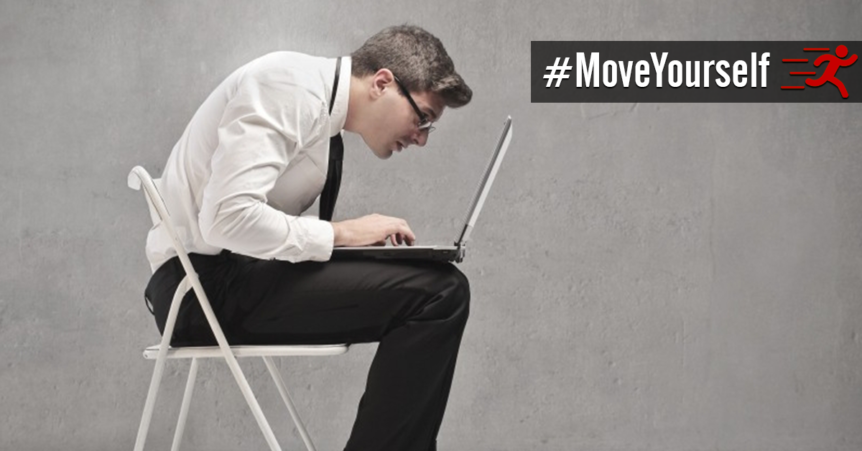Editor’s Note: The following is a guest post from posture specialist Zeena Dhalla, founder of Verticalign.com.
Listen to our accompanying podcast interview using the player below.
Three hours into your workday and you head to the break room, already sore from sitting all morning. Your lower back is on fire, and your neck feels tight. You place both hands on your back to give it a gentle massage. You bend over to stretch out your lower back, and then do a few head rolls to work on the neck. Not much else to do other than head back to your desk and pick right up where you left off. The achiness is still there, but you’re used to it by now, so it will be fine.
Except, it’s not fine.
The next day you pick up a laundry basket, and BOOM, your back goes out and suddenly you can’t move. Maybe it’s not your reality now, but it could be.
I’m Zeena, a Certified Posture Specialist and founder of www.VerticAlign.com, and this used to be me. There was a time where I could barely bend over to pick up the laundry basket.
According to the CDC, in a 2013 study, incidences of lower back pain amongst Americans continues to be on the rise, with now nearly 30% of people having lower back pain in the last 3 months.
You already know sitting is bad for you, so you decide to get a standing desk. Will it help with reducing pain from sitting all day long? Sure, it’s better. Especially if you alternate from sitting to standing so you aren’t static in your movement all day long. It’s the immobility that shortens and tightens your muscles, which in turn creates misalignment and strain on your joints and spine (not to mention what this chronic pain from not moving enough can do to your productivity).
According to the American Academy of Pain Medication, the annual cost due to chronic pain in the US ranges between $560 billion to $635 billion a year (as of 2010). This includes the costs associated with medical care and the economic loss from disability and lost wages.
What should we be doing to prevent chronic low back pain? How do we stop from becoming a statistic lost in the cycle of medical drugs, surgeries and chronic discomfort?
The crowd sourcing website Health Outcome takes feedback from real patients on the best treatment plan for their health issues. Over 44,000 people have reported that the number one treatment that has helped their lower back pain is not Chiropractic, not even Physical Therapy, but instead “postural modification”. This rates higher than Yoga, acupuncture, and even back surgery.
So what is this “postural modification” all about, and how can you strategically implement it into your day without adding too much work or time?
Your spine is the lifeblood of your body. It has curves in places that need curves, and is surrounded by muscles that control these curves.
Problems arise when one, or more, of these so called curves becomes bigger or smaller than it should be. The surrounding muscles then “freak out” or in more technical terms, they become atrophied, over-utilized, and downright painful.
Let’s dig deeper and look at two important areas of the body and explain more about how this applies to you. We will analyze the upper shoulder/head region, and the lower pelvis position.

STEP #1: Proper Upper Body Posture
The most common upper body postural deviation is something I call “hunchback posture.” This is where the shoulders round and the head juts forward. This position causes undue stress on the neck muscles and is often accompanied by uncomfortable neck pain. Forward head posture might also contribute to RSI’s (repetitive stress injuries) since the hand nerves originate in the neck.
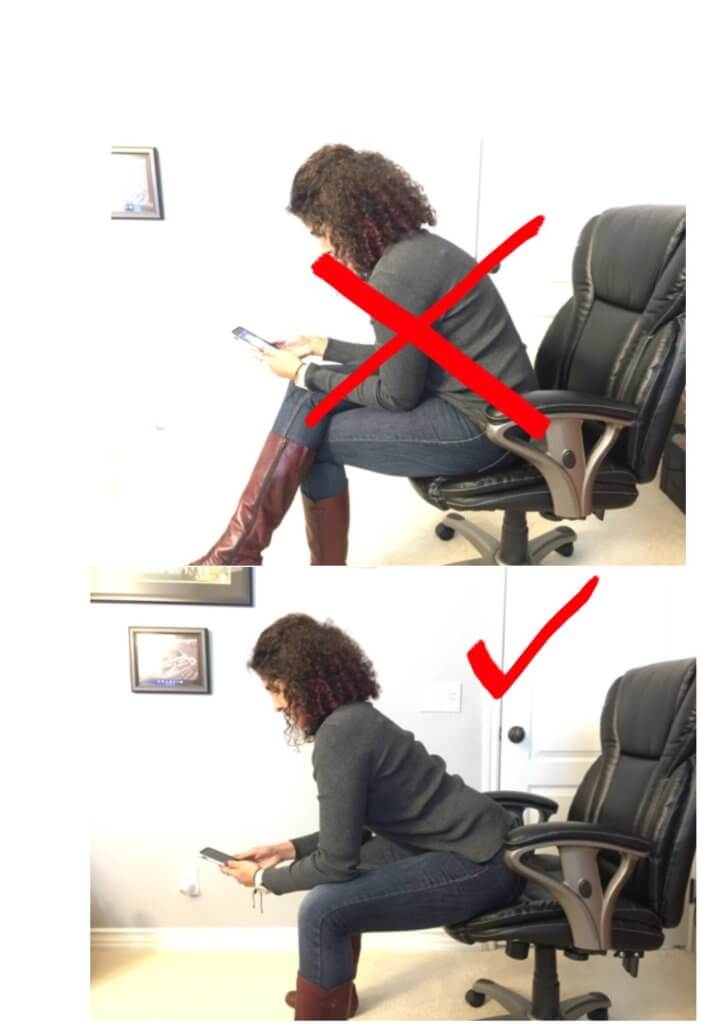
Sitting OR standing at a desk can cause hunchback posture, as well as texting while rounded forward on your cell phone.
Proper typing position can combat this postural deviation. The most important postural modifications when at the computer should be the position of the elbows in relation to the shoulders, and the position of the shoulders in relation to the tip of the ears.
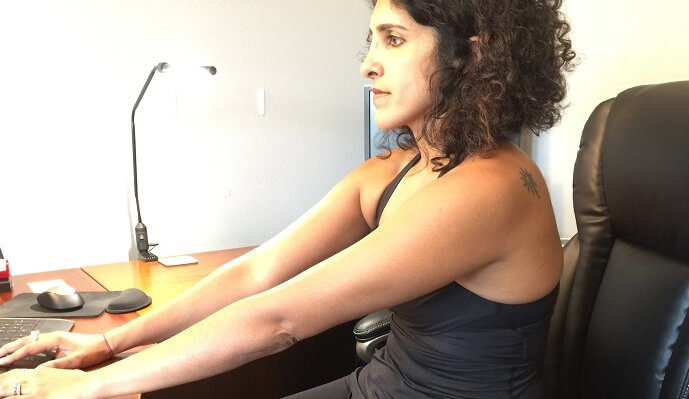
The elbows, when moved forward of the shoulder joint, activate muscles in the front of the shoulder joint (anterior deltoid) and front of the neck muscles (sternocleidomastoid and scalines). When sitting or standing in this position for a prolonged period of time, these muscles get tight and are over utilized. Sure, the elbows have to be a little bit in front of the shoulders in order to access and type on the keyboard. However, the closer they are to sitting beneath the shoulder joint, the better you can access the BACK muscles as opposed to just placing pressure on the front muscles.
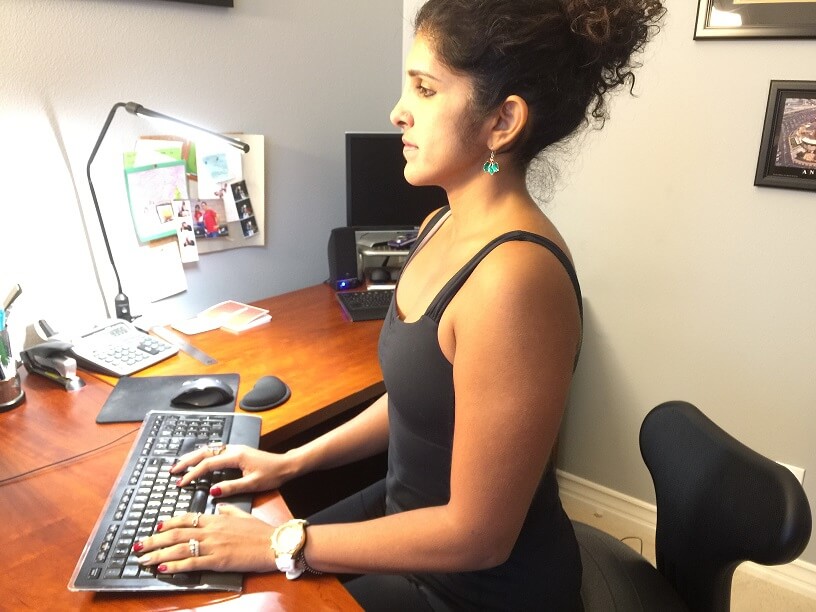
If you only remember one thing, remember that the back muscles are the bigger and better muscles to support the infrastructure of the spine versus the muscles on the front of the body.
Give it a try, move your elbows closer to your body. Do you feel how it forces you to pull shoulder shoulders back too, automatically forcing better posture? Now, pay attention to where your shoulders are in relation to the tip of your ear? Is your head jutting forward? If so, imagine there is a wall behind you, and pretend you are pushing your head against the wall. This completes the adjustments toward a better posture by aligning the ear directly over the shoulder joint.
STEP #2: Proper Lower Body (Pelvic) Posture
The body is not made of separate parts. In fact, it is a fully integrated system that relies on each of its parts for dynamic health. It’s impossible to fully “fix” a hunchback posture without also paying attention to the lower body.
The most prevalent lower body postural deviation in today’s technology driven world is the “posterior pelvic tilt.” More and more clients are walking into my studio with little to no arch in their lower back, which means they don’t have proper gluteal activation to support their backs (and knees and hips and ankles) properly. Here is a picture of someone sitting improperly, they are entirely hunched over, with both hunchback posture and a posterior pelvic tilt: This position is much more common in chronic sitters, and is usually avoided when at a standing desk.
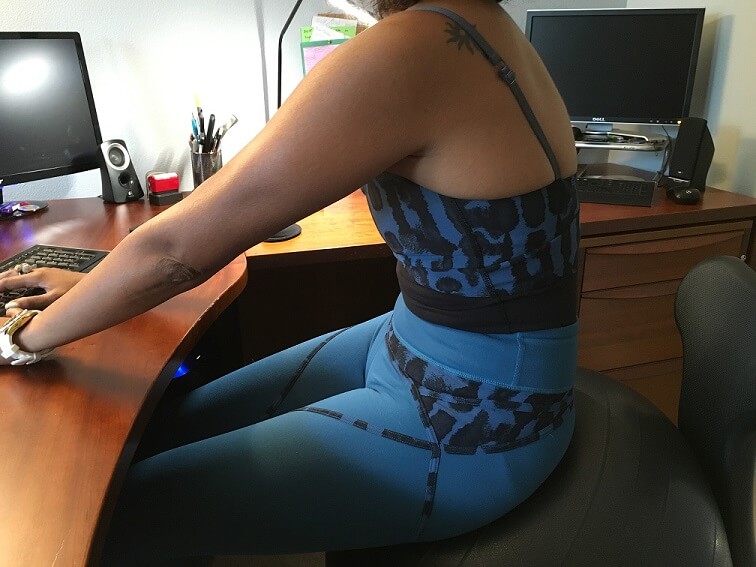
The best way to modify this position for sitting is to make sure the “sit bones” are placed correctly in relation to the chair you sit on.
Give it a try. First, stand up and place your fingers on your butt cheeks to find the body landmarks at the base of your pelvis called the “sit bones” (yes, your neighbor may look at your strangely). Then, sit down making sure you are sitting directly on these body landmarks. This probably forced your pelvis into more of an arch that you are used to sitting in, so take a moment to slightly “engage” your abdominals (pull your belly button into your spine) to make sure you’re not overcompensating and creating the opposite problem: the anterior pelvic tilt. Also pay attention to your bottom two ribs – are they sticking out? If so, you can also use your abs to pull these in towards the spine. Sitting in this position can get tiring if it’s new to you, so take breaks by rocking your pelvis forward and backward.
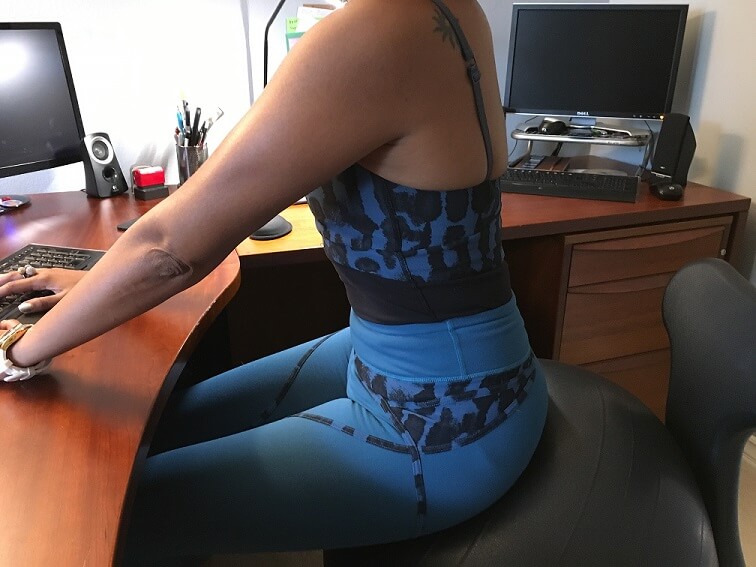
STEP #3: Engage in Hourly “Strategic Stretching”
The other day I was on a video conference call where you could see people listening to the call while they were “muted.” Sometimes I think these people forget they are being watched, so I watched one of the attendees systematically start to “stretch” various areas of his body. I was impressed. I was inspired. I decided to call it “strategic stretching” since it’s a smart way to affect postural change without taking time away from work.
Strategic stretching throughout the day can help to increase circulation and improve tissue tension length (i.e. flexibility).
In fact, if holding the desk sitting positions mentioned above seem difficult at first, give these stretches a try before you start your workday. Even better integrate them into your day if that works better for you. The increased mobility resulting from these stretches should help you hold proper posture more easily. Each stretch below combats a particular part of the body that chronically tightens up from sitting/standing immobility.
I suggest you pick ONE stretch to do every 1 to 1.5 hours. Try setting a timer on your phone to go off once every hour.
Standing Quad Stretch: You can do this one while on a conference call (even if people are watching you- show off your ability to balance on one foot).
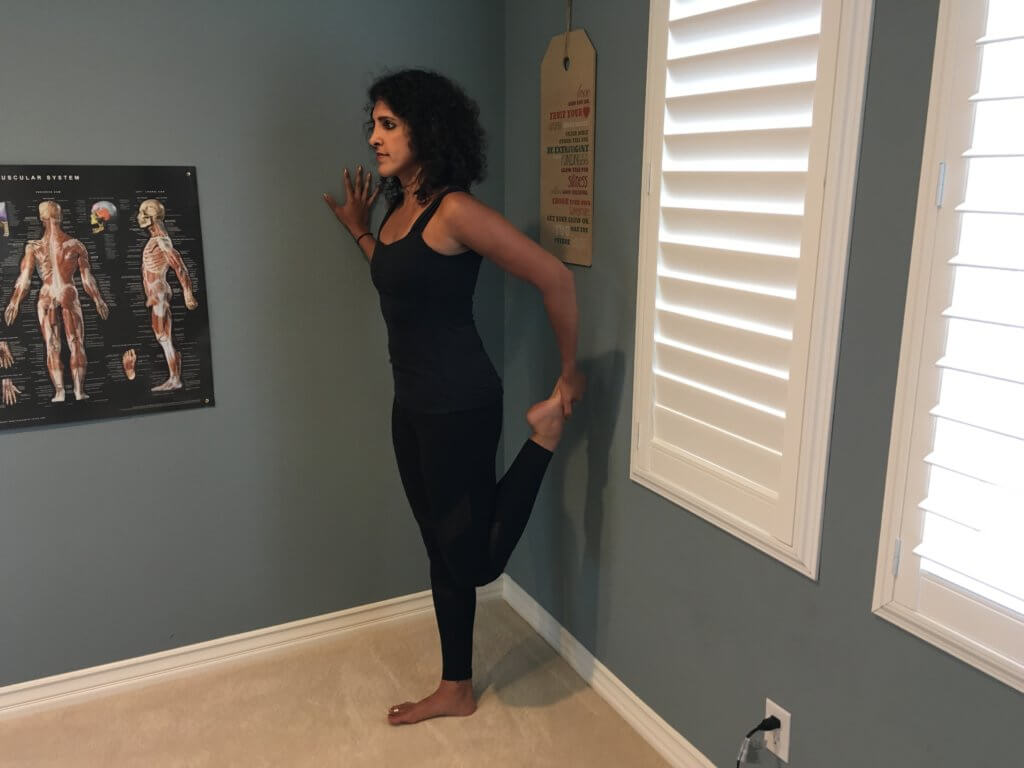
- Stand holding one foot behind you with a hand or a towel. Make sure the knees are parallel to each other and that the bent knee leg is not forward of the other leg.
- Squeeze the abdominals and glutes, and tuck the pelvis under slightly to increase the stretch on the top of the thigh.
- Hold for 1 minute on each leg.
Sitting Glute Stretch: This one is fantastic since you don’t even have to take your hands off the keyboard to do it!
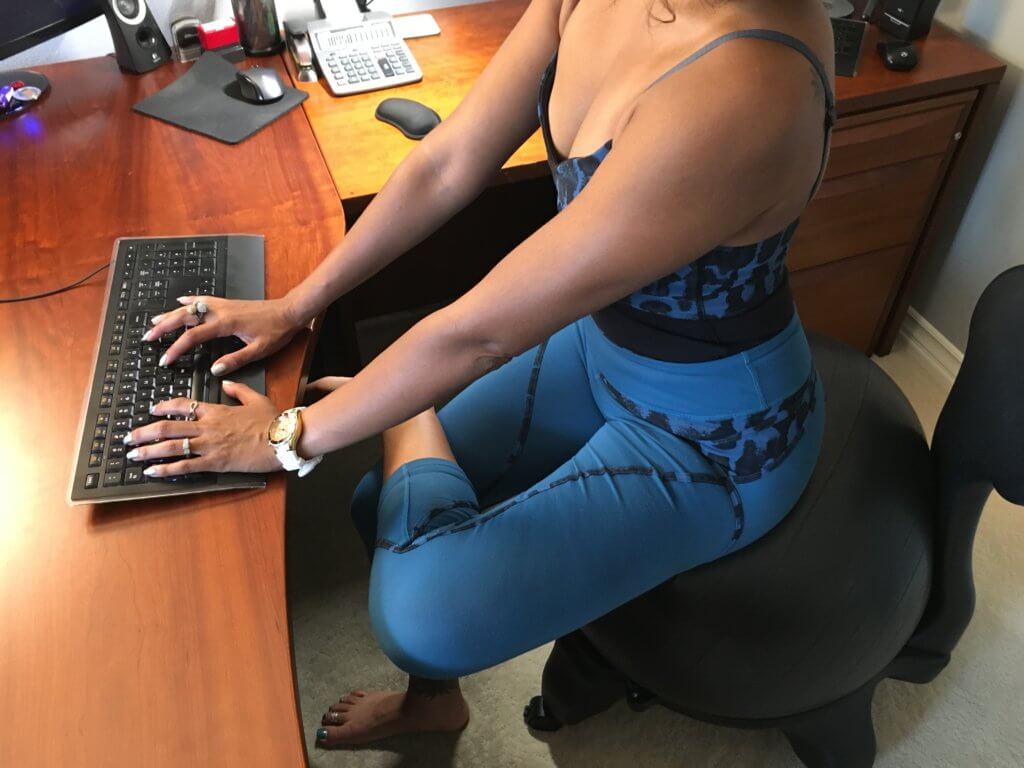
- Sit tall on your sit bones. Lift your right leg off the floor, open up your knee, and place your right ankle on top of your left knee. If you are super tight and can’t reach, straighten your left leg a bit so your knee is not too high.
- Push your right knee as far open as you can towards the ground. Do your best to sit as tall as you can. The taller you sit, the more stretch you will get.
- Hold this position for at least 1 minute on each side.
Standing Calf Drop Stretch: Ok, this one is a bit harder to squeeze in around the office but it’s amazing for leveling out the hips and increasing ankle joint mobility.
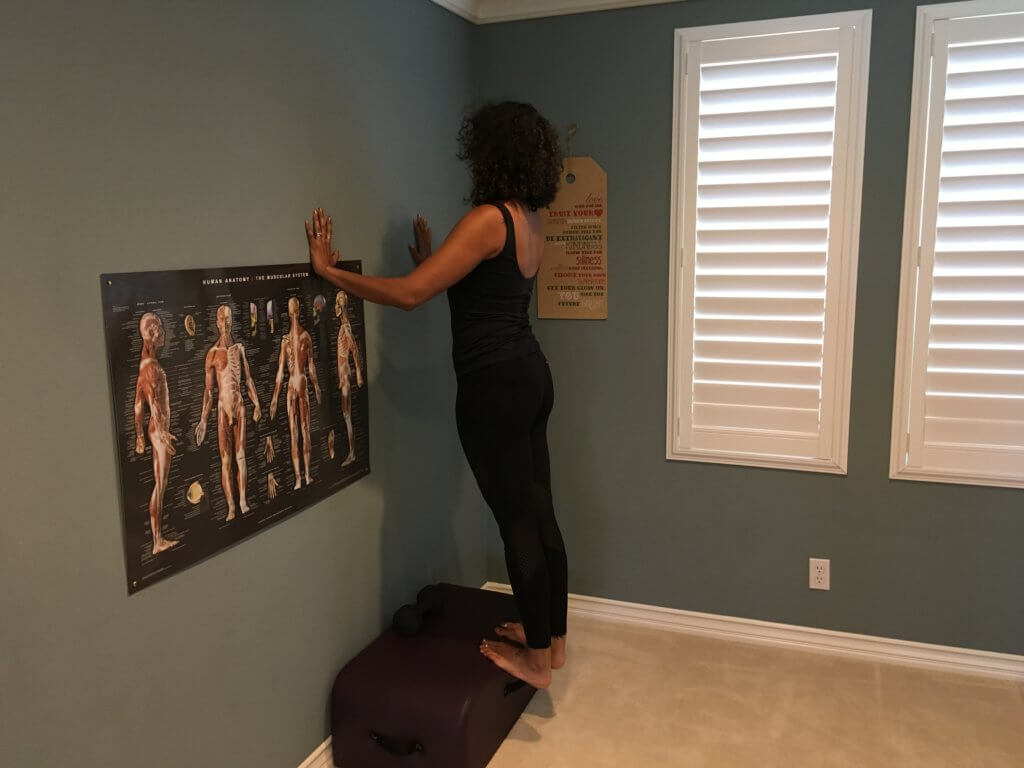
- Stand with good posture on a stair or step. Make sure you have a neutral pelvis and that your feet are in parallel position.
- Drop your heels down until you feel a calf stretch. Lean backwards so that the hips are over the feet. Squeeze the shoulder blades together. Hold on to a wall or railing for support.
- Hold this position for 1 to 3 minutes.
Sitting Chair Chest Stretch: You’ll have to take your hands off the keyboard for this one, but you don’t even have to get out your chair. Place a call on speaker and talk/stretch away!
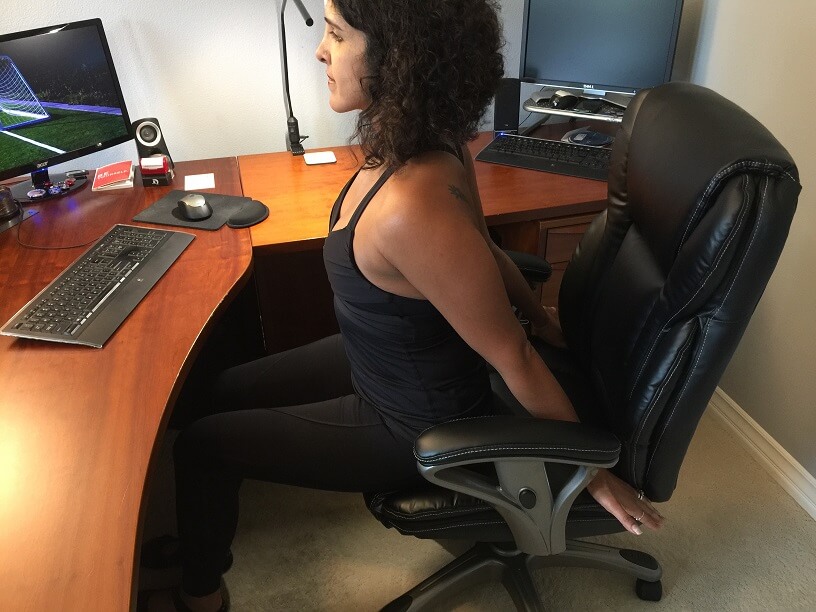
- Sit tall at the end of your chair. Reach both arms behind you and grab the back corners of your chair (seat) with your palms. Try to keep the arms as straight as possible. Notice that if you squeeze your shoulder blades together you might feel more stretch in your chest.
- Push into the chair with the hands gently, and you will feel your lats (big back muscles) engage a bit too. You should feel like you are pushing the chair forward towards the desk.
- Hold this for 1 minute.
Standing Lat Stretch: Find a doorway, (any doorway!) to maximize success on this one. Stretching these muscles tends to be a missing link for people with major hunchback posture!
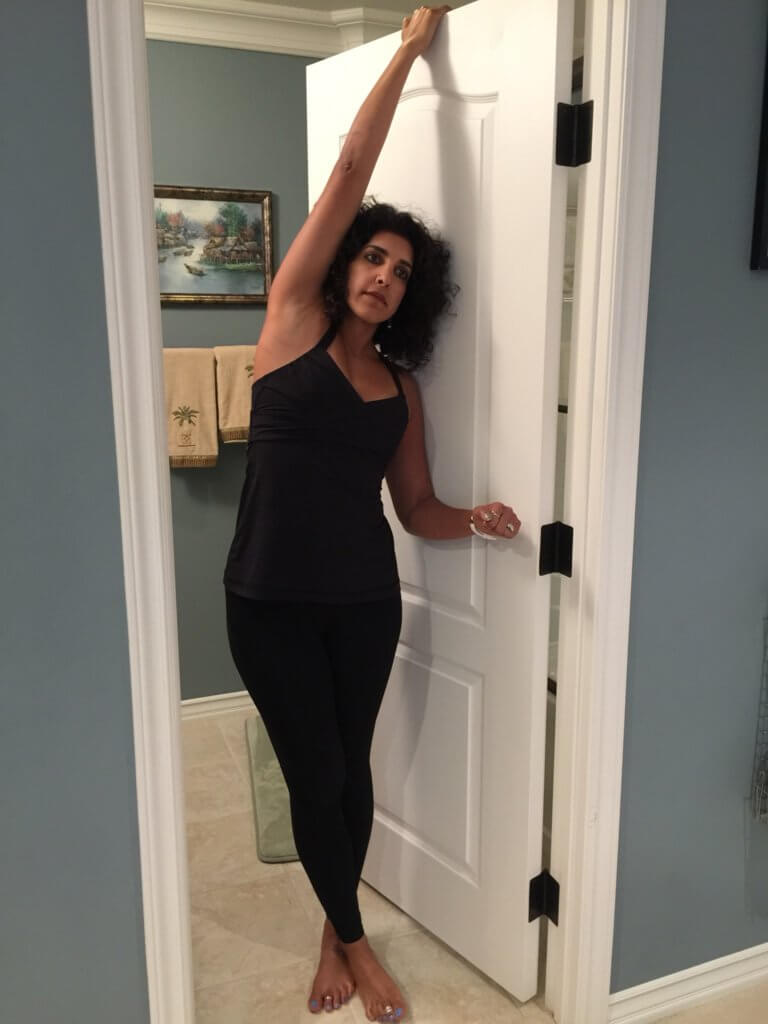
- Stand perpendicular to a door frame and place the outside hand on the top of the frame. Cross the outside leg in front of the inside leg.
- Use the inside arm to push the door away from you as you lean away, hanging by the top arm. You should feel a stretch down the side of the body from the armpit to the hip.
- Hold this position for 1 minute and repeat on the other side.
Powerful, Purposeful, Posture
When you place purpose and emphasis on your posture, you have the power to change the landscape of your day. These simple techniques in the form of “postural modification” will increase energy, skyrocket your productivity, decrease stress, improve your emotions, decrease pain and command you to you stand taller.
Everybody is different, and every person has additional stretches/exercises that can assist them on the road to a pain-free and more productive work day. Many of my clients spend an additional 5 to 20 minutes daily doing exercises and stretches to help combat the physical strain from their day. They have seen huge results from integrating a simple plan like this 5 Minute Solution to Hunchback Posture into their daily plan.
So, next time your brain reminds you to sit up straight, think “elbows back” and “sit bones support.” Next time your lower back feels sore when you get up and move around, instead of grabbing your back and moaning in discomfort, try the sitting glute stretch or standing quad stretch. When sitting on that long conference call, take both hands behind you on your chair for the sitting chest stretch. Postural modification can be easy to integrate into your work day, it just takes a little attention and a bit of strategy.

